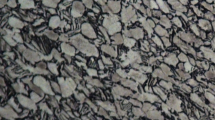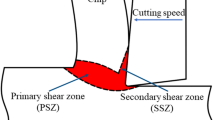Abstract
In this paper, a deep study of constitutive parameters definition effect is done in order to guarantee sufficient reliability of the finite element machining modeling. The case of a particular biphasic titanium alloy Ti6Al4V known by its low machinability is investigated. The Johnson-Cook (JC) elasto-thermo-visco-plastic-damage model combined with the energy-based ductile fracture criteria is used. Segmentation frequency, chip curvature radius, shear band spacing, chip serration sensitivity and intensity, accumulated plastic strain in the formed chip segments, and cutting forces levels are determined where their dependency to every constitutive coefficient is examined and highlighted. It is demonstrated from the separate variation of every plastic and damage parameters that an interesting finite element modeling (FEM) relevance is reached with the adjustment of JC strain hardening coefficients term, thermal softening parameter, exponent fracture factor, and damage evolution energy. Moderate and high cutting speeds are applied to the cutting tool in the aim to test their impact on shear localization, chip segmentation, and numerical forces levels as well as to approve previous highlighted findings related to constitutive parameters definition. In general, this study focuses on a prominent decrease in identification process cost with the previous knowledge of the most affecting constitutive coefficients while keeping an interesting agreement between numerical and experimental results.
Similar content being viewed by others
References
Daoud M, Chatelain JF, Bouzid A (2015) Effect of rake angle on Johnson-Cook material constants and their impact on cutting process parameters of Al2024-T3 alloy machining simulation. Int J Adv Manuf Technol 81:1987–1997
Arrazola PJ, Ugate D, J.Montoya, Villar A, Marya S (2005) Finite element modeling of chip formation process with Abaqus/Explicit™6.3. VIII International Conference on Computational Plasticity COMPLAS VIII
Sutter G, List G (2013) Very high speed cutting of Ti-6Al-4V titanium alloy-change in morphology and mechanism of chip formation. Int J Mach Tools Manuf 66:37–43
Molinari A, Soldani X, Miguélez MH (2013) Adiabatic shear banding and scaling laws in chip formation with application to cutting of Ti-6Al-4V. J Mech Phys Solids 61:2331–2359
Ginting A, Nouari M (2009) Surface integrity of dry machined titanium alloys. Int J Mach Tools Manuf 49:325–332
Muñez-Sánchez A, Canteli JA, Cantero JL, Miguélez MH (2011) Numerical analysis of the tool wear effect in the machining induced residual stresses. Simul Model Pract Theory 19:872–886
Davies MA, Chou Y, Evans CJ (1996) On chip morphology, tool wear and cutting mechanics in finish hard turning. CIRP Ann Manuf Technol 45:77–82
Molinari A, Musquar C, Sutter G (2002) Adiabatic shear banding in high speed machining of Ti-6Al-4V: experiments and modeling. Int J Plast 18:443–459
Calamaz M, Coupard D, Girot F (2008) A new material model for 2D numerical simulation of serrated chip formation when machining titanium alloy Ti-6Al-4V. Int J Mach Tools Manuf 48:275–288
Wang B, Lui Z, Yang Q (2013) Investigations of the yield stress, fracture toughness and energy distribution in high speed orthogonal cutting. Int J Mach Tools Manuf 73:1–8
Komanduri R, Von Turkovich BF (1981) New observations on the mechanism of chip formation when machining titanium alloys. Wear 69:179–188
Ambati R, Yuan H (2011) FEM mesh-dependence in cutting process simulations. Int J Adv Manuf Technol 53:313–323
Hua J, Shivpuri R (2004) Prediction of chip morphology and segmentation during the machining of titanium alloys. J Mater Process Technol 150:124–133
Shaw MC, Vyas A (1998) The mechanism of chip formation with hard turning steel. CIRP Ann Manuf Technol 47:77–82
Lin ZC, Lin YY (2001) Three dimensional elastic-plastic finite element analysis for orthogonal cutting with discontinuous chip of 6-4 brass. Theor Appl Fract Mech 35:137–153
Deshayes L, Mabrouki T, Ivester R, Rigal JF (2004) Serrated chip morphology and comparison with finite element simulations. Proceedings of IMECE2004-ASME 2004 International Mechanical Engineering Congress and Exposition
Ducobu F (2013) Contribution à l’étude de la formation du copeau de Ti6Al4Ven coupe orthogonale-Approches numérique et expérimentale pour la compréhension des mécanismes de coupe macroscopique et microscopique. PhD Thesis, Polytechnic Faculty of Mons, Belgium
Braham-Bouchnak T (2010) Etude du comportement en sollicitations extrêmes et de l’usinabilité d’un nouvel alliage de titane aéronautique: le Ti555-3. PhD Thesis, Centre of Angers, France
Sartkulvanich P, Altan T, Soehner J (2005) Flow stress data for finite element simulation in metal cutting: a progress report on madams. Mach Sci Technol 9:271–288
Chen G, Ren C, Yang X, Jin X, Guo T (2011) Finite element simulation of high-speed machining of titanium alloy (Ti-6Al-4V) based on ductile failure model. Int J Adv Manuf Technol 56:1027–1038
Germain G, Morel A, Braham-Bouchnak T (2013) Identification of material constitutive laws representative of machining conditions of two titanium alloys: Ti6Al4V and Ti555-3. J Eng Mater-T ASME 135
Daoud M, Jomoaa W, Chatelain JF, Bouzid A (2015) A machining-based methodology to identify material constitutive law for finite element simulation. Int J Adv Manuf Technol 77:2019–2033
Agmell M, Ahadi A, Ståhl J-E (2013) The link between plasticity parameters and process parameters in orthogonal cutting. 14th CIRP Conference on Modelling of Machining Operations 8:224-229
Umbrello D, M’Saoubi R, Outeiro JC (2007) The influence of Johnson-Cook material constants on finite element simulation of machining of AISI 316L steel. Int J Mach Tools Manuf 47:462–470
Guo YB, Wen Q, Woodbury KA (2006) Dynamic material behavior modeling using internal state variable plasticity and its application in hard machining simulations. J Manuf Sci Eng 128:749–756
Ducobu F, Rivière-Lorphèvre E, Filippi E (2014) Numerical contribution to the comprehension of saw-toothed Ti6Al4V chip formation in orthogonal cutting. Int J Mech Sci 81:77–87
Calamaz M (2008) Approches expérimentale et numérique de l’usinage à sec de l’alliage aéronautique TA 6V. PhD Thesis, University of Bordeaux, France
Barge M, Hamdi H, Rech J, Bergheau J-M (2005) Numerical modelling of orthogonal cutting: influence of numerical parameters. J Mater Process Technol 164–165:1148–1153
Johnson GR, Cook WH (1983) A constitutive model and data for metals subjected to large strains, high strain rates and high temperatures. Proceedings of the Seventh International Symposium on Ballastics, The Hague, the Netherlands, 541-547
Mabrouki T, Girardin F, Asad M, Rigal J-F (2008) Numerical and experimental study of dry cutting for an aeronautic aluminum alloy. Int J Mach Tools Manuf 48:1187–1197
Umbrello D (2008) Finite element simulation of conventional and high speed machining of Ti6Al4V alloy. J Mater Process Technol 196:79–87
Guo YB, Yen DW (2004) A FEM study on mechanisms of discontinuous chip formation in hard machining. J Mater Process Technol 155–156:1350–1356
Sima M, Özel T (2010) Modified material constitutive models for serrated chip formation simulations and experimental validation in machining of titanium alloy Ti-6AL-4V. Int J Mach Tools Manuf 50:943–960
Calamaz M, Coupard D, Nouari M, Girot F (2011) Numerical analysis of chip formation and shear localisation processes in machining the Ti-6Al-4V titanium alloy. Int J Adv Manuf Technol 52:887–895
Ohbuchi Y, Obikawa T (2005) Adiabatic shear in chip formation with negative rake angle. Int J Mech Sci 47:1377–1392
Rhim S-H, Oh S-I (2006) Prediction of serrated chip formation in metal cutting process with new flow stress model for AISI 1045 steel. J Mater Process Technol 171:417–422
Johnson GR, Cook WH (1985) Fracture characteristics of three metals subjected to various strains, strain rates, temperatures and pressures. Eng Fract Mech 21:31–48
Hillerborg A, Modéer M, Petersson P-E (1976) Analysis of crack formation and crack growth in concrete by means of fracture mechanics and finite elements. Cem Concr Res 6:773–782
Zhang Y, Outeiro JC, Mabrouki T (2015) On the selection of Johnson-Cook constitutive model parameters for Ti-6Al-4V using three types of numerical models of orthogonal cutting. 15th CIRP Conference on Modelling of Machining Operations 31:112-117
ABAQUS User’s Manual (2013) Abaqus/Explicit® version 6.13. Dassault Systems Simulia Corp., Providence
Liu J, Bai Y, Xu C (2013) Evaluation of ductile fracture models in finite element simulation of metal cutting processes. Journal of Manufacturing Science Engineering 136(1)
Miguelez MH, Soldani X, Molinari A (2013) Analysis of adiabatic shear banding in orthogonal cutting of Ti alloy. Int J Mech Sci 75:212–222
Haddag B, Abed-Meraim F, Balan T (2009) Strain localization analysis using a large deformation anisotropic elastic-plastic model coupled with damage. Int J Plast 25:1970–1996
Shet C, Deng X (2000) Finite element analysis of the orthogonal metal cutting process. J Mater Process Technol 105:95–109
Özel T (2006) The influence of friction models on finite element simulations of machining. Int J Mach Tools Manuf 46:518–530
Filice L, Micari F, Rizzuti S, Umbrello D (2007) A critical analysis on the friction modelling in orthogonal machining. Int J Mach Tools Manuf 47:709–714
Zorev NN (1963) Inter-relationship between shear processes occurring along the tool face and shear plane in metal cutting. International Research in Production Engineering ASME 42-49
Atlati S, Haddag B, Nouari M, Zenasni M (2011) Analysis of a new segmentation intensity ratio “SIR” to characterize the chip segmentation process in machining ductile metals. Int J Mach Tools Manuf 51:687–700
Haddag B, Atlati S, Nouari M, Znasni M (2010) Finite element formulation effect in three-dimensional modeling of a chip formation during machining. Int J Mater Form 3:527–530
Sun S, Brandt M, Dargusch MS (2009) Characteristics of cutting forces and chip formation in machining of titanium alloys. Int J Mach Tools Manuf 49:561–568
Wang B, Liu Z (2015) Shear localization sensitivity analysis for Johnson-Cook constitutive parameters on serrated chips in high speed machining of Ti6Al4V. Simul Model Pract Theory 55:63–76
Author information
Authors and Affiliations
Corresponding author
Rights and permissions
About this article
Cite this article
Yaich, M., Ayed, Y., Bouaziz, Z. et al. Numerical analysis of constitutive coefficients effects on FE simulation of the 2D orthogonal cutting process: application to the Ti6Al4V. Int J Adv Manuf Technol 93, 283–303 (2017). https://doi.org/10.1007/s00170-016-8934-4
Received:
Accepted:
Published:
Issue Date:
DOI: https://doi.org/10.1007/s00170-016-8934-4




